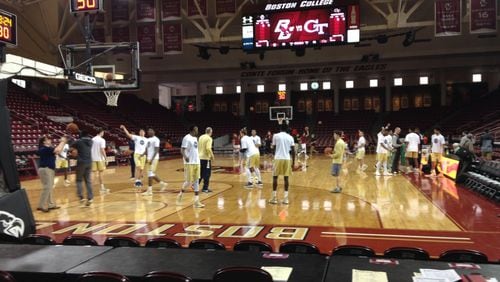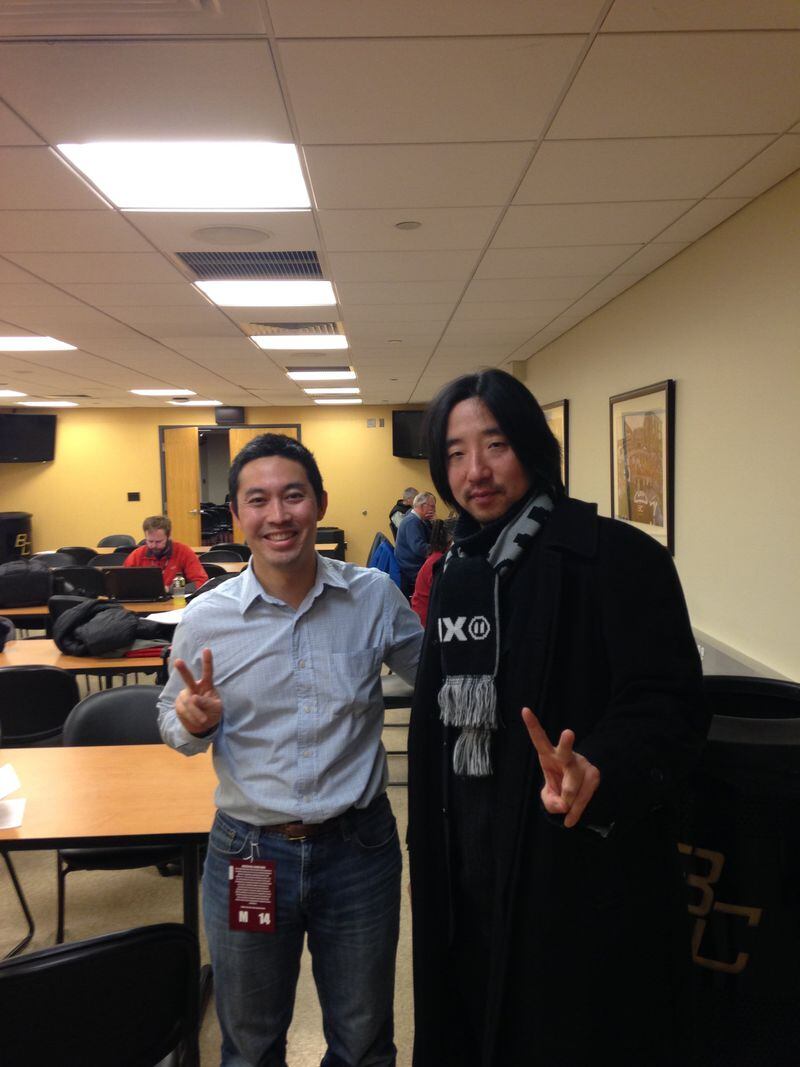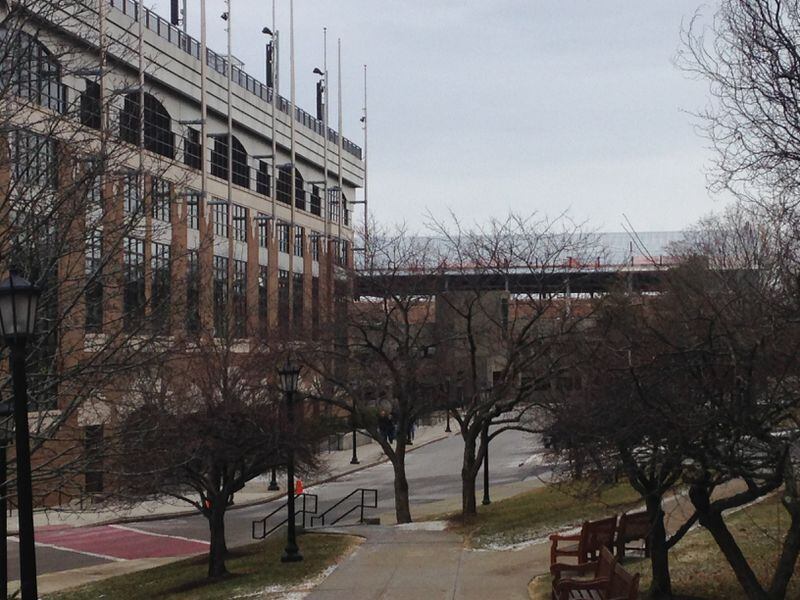A further review of Georgia Tech's 80-72 loss to Boston College Sunday in Chestnut Hill, Mass. For the "5 observations" story from the game, please read here.
1. One of Georgia Tech's problems this season can be summarized in a tidy statistic. When the Yellow Jackets are ahead at halftime, they're 9-5. That sounds OK, but not when compared to the flipped situation.
When trailing at the half, the Jackets are 1-7. (They are 1-0 when tied at the half, against Miami.)
When looking at the nine wins, four can reasonably tossed out as games in which Tech was demonstrably better and there was not much chance of a comeback – Florida A&M, North Texas, UT-Rio Grande Valley and Bethune-Cookman. That means that, this season, when Tech has taken a lead after 20 minutes against a reasonably comparable opponent, it’s been only a 50-50 bet that the Jackets would end the game in the lead.
It happened again Sunday, when Tech led Boston College 36-28 at the half before falling 80-72 in overtime. The other come-from-ahead losses this season – Wofford (34-29 at the half, 63-60 at game’s end), Wright State (40-31 before losing 54-41), Notre Dame (28-23/68-59) and Clemson (38-36/72-70).
Coach Josh Pastner cited a lack of toughness to explain the Jackets’ inability to build leads, as happened against Boston College. Center Ben Lammers struck a similar note, explaining that players have gotten satisfied or overconfident after taking a lead like they did against Boston College (13 points with five minutes left in the half).
Fatigue might be a possibility, given the heavy minutes that players like Lammers and point guard Jose Alvarado log. It might be that due to the team’s limitations offensively, the Jackets can only sustain a stretch of efficient offensive play for so long.
Which leads to point No. 2.
2. Failings in 3-point defense have been culpable in defeat as well. The Irish made four of 10 3-pointers in the second half of their comeback in South Bend, Ind. The opponents' 3-point shooting in the other four losses in which Tech was ahead at halftime:
Wofford was 12-for-30 from 3-point range.
Wright State was 9-for-20.
Georgia was 9-for-19.
Clemson was 10-for-21.
Boston College was 11-for-23.
In those games, the opposition has used 3-pointers to stay in the game when Tech was effective offensively and its opponent was not, or as a way to quickly climb back into a game. It goes a long way to explaining why Tech hasn’t been able to grow leads when it’s been making hay on offense.
Another stat: Tech is 4-10 when its opponent shoots 34 percent or better from 3-point range, and the four wins are against North Texas (RPI: 209), Coppin State (339), Pittsburgh (179 and 0-11 in the ACC) and Bethune-Cookman (298). The Jackets are 7-2 when they keep teams under 34 percent from 3-point range.
Tech runs into problems when the other team is hot from 3-point range not only for the obvious reason, that the other team is accumulating points quickly. It’s also problematic because Tech can’t match.
The Jackets average 4.7 successful 3-pointers per game. After Sunday’s games, that was 348th out of 351 Division I teams. Tech doesn’t take many 3-pointers because the Jackets aren’t good at making them. The Jackets’ rate of 3-point field-goal attempts per field-goal attempt is 340th nationally (KenPom).
So when the Jackets are humming offensively, they’re largely doing so two points at a time.
That also helps explain why Tech’s record when trailing at the half with him is so poor, because the Jackets can’t reliably get back into games via the 3-pointer.
It’s kind of like a car race where one car’s top speed is 50 miles per hour and the other car’s top speed is 75.
The good news for Tech is that the Jackets are defending the 3-point shot better in ACC play. The bad news is that the team’s best 3-point threat, Curtis Haywood, won’t play the rest of the season. He was 13-for-26 when he went down with his shin injury. He was not the same when he came back, and since has been shut down.
Guards Josh Okogie (38 percent from 3-point range) and Alvarado (36.5 percent) are both capable from long range, but part of their rates are due to being selective. Pastner wants guard Brandon Alston to become a 3-point threat (he describes his role as “3 and D” - meaning 3-pointers and defense) and he has the stroke to do it. But his attempts are also limited, 1.9 per game.
3. Tech is now at 12 losses (against 11 wins). It's another game (along with the losses to Clemson, Notre Dame, Grambling State, Wofford and Wright State) that Tech could have had with marginally better play.
Frankly, though, it’s not a game the team deserved, per se, unlike maybe the Clemson loss. The Jackets made enough mistakes and fell into enough familiar potholes that defeat was neither a surprise nor particularly undue. The team has limitations and played beneath them.
But one thing that stuck out to me was the play of Alvarado. He did have four turnovers (he had a 10/3 assist/turnover ratio in the past two games), but he’s become markedly better in recent games at driving to the basket and finding outlets on the perimeter for jumpers rather than driving and throwing up layups with little chance of going in.
He’s getting there, and it’s been intriguging to watch him develop.
4. Both Alvarado and Lammers played all 45 minutes of Sunday's overtime loss to Boston College. It was the first time that a Tech player had played all 45 minutes of a one-overtime game since Alvin Jones in 1998.
5. Sunday was kind of a fun day for me for a random reason. The writer seated next to me was Daisuke Sugiura, who was at the game for Yahoo Japan. It's the first time I've covered an event alongside another Sugiura, at least knowingly. Daisuke, who is based in New York, was there to talk with Avi Schafer, the Tech walk-on freshman. Schafer was born and raised in Japan (his mother is Japanese) and he apparently has a chance to make the Japanese Olympic team when the Games come to Tokyo in 2020. (Schafer played for Japan's U19 team at the U19 world championships this past summer in Egypt, the same tournament in which Okogie played for the U.S. team.)
Daisuke and I are not related, at least not to my knowledge. Sugiura is a somewhat common Japanese surname.
6. A summary of my Uber rides in Boston:
The guy who drove me from the North End in Boston to my hotel asked me about the Super Bowl – who I was rooting for, etc. – and then he said something like, “The Eagles – I don’t even know what state they’re from.” The Super Bowl talk kind of ended after that.
The woman who drove me from the hotel to the Conte Forum is an Uber driver in her spare time when her job – real estate agent – slows down. She was telling me how crazy the market is in Boston.
I was asking her about in-fill homes – houses that are built after the original is knocked down – and she was telling me about a town she concentrates on (either Lexington or Arlington) and how developers knock down houses worth up to $650,000 to build on top of them because they can sell new homes for $1-2 million.
The last guy – Conte Forum to Logan – was fired up because his map was showing that there was high demand for rides from Logan. I said it’s probably because would-be drivers are staying home to watch the game. The driver (English was not his first language) picked up on that and said something about how it’s because all the Uber drivers are at Gillette Stadium.
I didn’t bother to correct him, but I guess that partly explains why he was driving and not watching. He also told me that he had a daughter who was 23 years old and another child (I forget the gender) who was less than a year old.
About the Author









